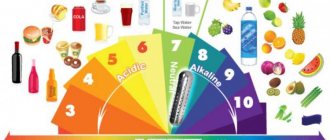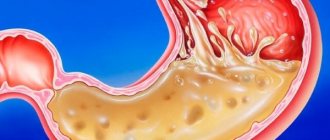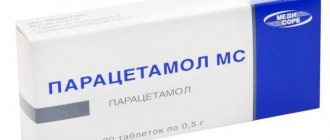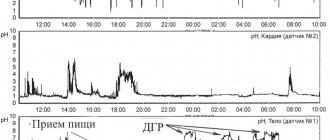gastritis
bloating
diarrhea
sour taste in mouth
Helicobacter pylori
What are the consequences of changes in stomach acidity?
The main danger of increasing the secretory function of the stomach is the development of an inflammatory process in the mucous membrane of the organ, followed by its damage and the development of structural defects. A change in the pH of the gastric environment is always accompanied by clinical symptoms, the severity of which depends on the severity of the inflammatory process and the nature of the structural and functional disorders.
Stomach acidity, why it is dangerous
Increased stomach acidity leads to gastritis and stomach ulcers
Normally, due to the fundic cells localized in the gastric mucosa, a complex interconnected process occurs, which leads to the production of hydrochloric acid.
It is this chemical compound, in combination with mucus and other substances, that causes the maintenance of an adequate pH level in the stomach cavity. Normally, the gastric environment is acidic. Due to it, the following processes occur in digestion:
- Breakdown of nutrients for the stepwise processes of digestive function.
- Destruction of pathogenic microorganisms that can pose a great danger to surrounding people.
An imbalance in the production of hydrochloric acid can be dangerous to human health, since a violation of general hemostasis leads to changes in the internal environment and various kinds of diseases, including:
- Gastritis. Focal or diffuse lesions of the gastric mucosa, in which not only the digestion process is disrupted, but also severe pain is noted. Morphologically, gastritis represents swelling of the gastric mucosa and disruption of the functioning of the glands.
- Stomach ulcer. As a result of this process, an ulcerative defect is formed on the mucous membrane with a violation of the integrity of the skin. Peptic ulcer disease is a life-threatening condition, as it can be complicated by perforation with the formation of severe bleeding, peritonitis and pain.
- An ulcer with high acidity can be localized not only in the stomach, but also in the duodenum.
- The reflux of gastric contents is often the cause of chronic inflammatory processes in the pancreas and liver.
Possible complications
If the doctor’s recommendations are not followed or therapy is inadequate, gastritis can be complicated by the following pathological conditions:
- digestive disorders in the form of malabsorption and dyspepsia;
- vitamin B deficiency;
- peptic ulcer: most often develops with the erosive form of gastritis;
- gastric bleeding: occurs with ulcers and erosions. Clinical signs will include pallor, weakness, cold and sticky sweat, shortness of breath, tachycardia, the presence of blood in the vomit, black stools. This condition requires immediate hospitalization;
- atrophic gastritis: the glands of the mucous membrane almost completely stop producing secretions, the process of replacement with scar tissue begins, it refers to a prenatal condition, the likelihood of malignancy is extremely high;
- iron deficiency anemia (develops with low production of Castle factor);
- stomach cancer.
During an exacerbation, severe complications can develop within several days, and sometimes even one day.
Causes
As a result of the fact that increased or decreased acidity is not a normal option, it is necessary to take into account that each of the conditions requires correction and the possible prescription of medications. Before starting treatment, it is necessary to establish the cause that led to this condition, among them are:
- Eating disorder. This group includes a large number of factors, among which are general dietary disorders with long breaks leading to hunger, lack of frequent and split meals, and the inclusion in the menu of foods rich in salt, spices, refined oils and other substances.
- Consumption of alcohol and alcohol-containing products. These drinks contribute to the rapid development of high acidity. With one-time use, acidity will increase for a short period of time, but regular use causes a persistent disruption of homeostasis.
- Smoking. The process of smoking, regardless of the type of product, leads to stimulation of the parietal cells of the stomach, as a result of which their functional activity increases.
- Stressful influences. Regular stressful situations largely cause an increase in acidity, which forms an inflammatory process and a decrease in the body's defenses.
- Insufficient intake of vitamins. This reason is similar to the problem of malnutrition, since products that contain them are recommended to be consumed in a non-heat-treated form.
- Taking medications. There are a large number of drugs that can increase the level of acidity in the stomach. If it is impossible to cancel them, it is recommended to combine medications with agents that have protective reactions on the mucous membrane.
- The presence of tumor processes in the brain or pancreas, which cause disruption of communication between the nervous system and parietal cells. The most common type of hormonally active tumor is gastrinoma.
Diagnostics
If the first symptoms of low stomach acid appear, it is necessary to undergo diagnostics to confirm the diagnosis. To do this, the patient must undergo a blood test, after which the composition of the gastric juice is examined to determine its pH, for this purpose probing is used.
Acidity in all parts of the stomach can be determined through instrumental diagnostics - intragastric pH-metry. This method allows the doctor to form a complete picture of the level of acidity in the patient’s stomach, identify problem areas and begin drawing up a treatment plan taking into account the data obtained. This approach is the most effective in terms of achieving a positive result.
Practical implementation of the survey
As part of the examination, the patient undergoes several procedures; based on the results obtained, the doctor forms an idea of the scale of the problem and the overall clinical picture.
First of all, the patient is sent for an ultrasound of the gastrointestinal tract, after which he undergoes endoscopy of the stomach, then an x-ray of the stomach and duodenum; at the final stage of the examination, differential diagnosis is performed, special attention is paid to it, since the pathology in question can be caused by various reasons.
Symptoms of high acidity
Heartburn is one of the symptoms of high stomach acidity
Among the main symptoms that reflect increased acidity in the stomach are:
- Poor digestion of food with the formation of putrid odor from the mouth and a tendency to bloating and constipation. This is caused by food remaining in the stomach cavity for a long time, which leads to its rotting, especially for protein particles.
- The appearance of nausea and vomiting that occurs after eating food.
- The development of heartburn, accompanied by a burning sensation in the area of the esophagus and oral cavity; heartburn is associated with the reflux of bile into the esophagus and overlying sections, which forms the development of burns on the vulnerable mucous membrane.
- Development of pain after eating food and within an hour.
- The appearance of pale skin, dryness and decreased elasticity. This is due to impaired absorption of beneficial microelements and vital nutrients. The most common laboratory criterion for such manifestations is anemia.
- The development of fragility and dryness of hair, hair loss, and the formation of acne. The cause of such disorders is vitamin deficiency.
- Decreased immunity as a result of the formation of toxic undigested products that cause intestinal fermentation.
How to diagnose hypoacid gastritis
If you notice similar symptoms, you should consult a specialist in the field of gastroenterology for diagnosis. To determine the clinical picture and make a correct and accurate diagnosis, the doctor usually conducts an examination, finds out complaints and prescribes tests and studies, as a result of which the type of pathology and how affected the gastric mucosa is determined. To determine chronic hypoacid gastritis use:
- visual examination of the stomach using a gastroscope (gastroscopy);
- endoscopic biopsy (taking material for biopsy);
- pH-metry of the acidity of secreted gastric juice;
- blood tests and coprogram.
Having collected a complete picture as a result of instrumental and laboratory studies, the doctor proceeds to drawing up a treatment program.
Basic nutrition rules
Regardless of what purpose the specialist or patient is pressing, which will cause an increase or, conversely, a decrease in stomach acidity, it is necessary to follow several basic rules, which include the following measures:
- Changing the nature of nutrition. Meals should always be frequent and small. It is forbidden to eat large portions of foods, as the stomach becomes overstretched and the parietal cells do not produce enough acid. This causes fermentation, bloating and abdominal pain.
- It is not recommended to consume fried or smoked foods, as the carcinogens they contain increase the risk of not only acidity disorders, but also malignant processes.
- Drinking enough liquid. According to many patients, the most beneficial is water with lemon added. It leads to increased acidity, which is dangerous for patients with initially reduced acidity levels.
- Complete exclusion of alcohol-containing products from the diet. To give up smoking.
- Limiting the use of medications. It is recommended to exclude medications as much as possible if they do not affect acidity. Continuation of therapy is mandatory when their deficiency can be life-threatening.
- Elimination of stress, emotional overload and other problems with the functioning of the nervous system.
Normalizing nutrition prevents the development of high stomach acidity. In order to prevent hydrochloric acid from accumulating in the stomach cavity, it is necessary to regularly adhere to fractional meals.
Among the foods that reduce the level of hydrochloric acid are:
- Dairy products that are not fermented include milk, cottage cheese and cheese.
- Fruit and vegetable dishes.
- Low-fat boiled meats.
- Boiled lean fish.
- Whole grain porridge.
Before creating the required diet, it is imperative to consult with a specialist. Only a doctor will be able to accurately identify the cause and, based on it, choose the most suitable and missing products for the body. A prerequisite is the selection of products taking into account calorie content and nutrient composition.
If necessary, the doctor selects a medicinal drink consisting of mineral waters and other drinks. Including them in the diet without prior examination can cause serious consequences for the body.
Taking water
Water with bicarbonate will help normalize acidity
Currently, in pharmacies and stores you can find a large amount of water that is used for medicinal purposes. Among them are sulfate, alkaline, chloride and other types of drinks.
The choice depends on the type of pathology for which the patient consults a doctor. Against the background of increased acidity, which leads to gastritis and peptic ulcers, it is recommended to include water containing bicarbonates in the diet.
The use of this mineral water leads to a decrease in the level of hydrochloric acid due to the entry of its ions with bicarbonate, which is an alkaline solution. As a result of a complex chemical reaction, neutralization occurs.
In addition, bicarbonates absorbed into the internal environment come into contact with a hydrogen ion. It is these ions that are involved in the production of gastric acid. During the treatment, the patient notes an improvement in well-being, a decrease in nausea and heartburn.
Great importance is also paid to its temperature; it is recommended to use heated water, which eliminates excess carbon dioxide content. The volume of liquid drunk should be up to a liter. It must be taken before eating food, since on an empty stomach the amount of hydrochloric acid is high.
Hypoacid gastritis: treatment
The treatment of such gastritis is based on an integrated approach using various methods and medications acting in different directions.
- To return the functioning of the digestive system to normal, replacement therapy is used (preparations of natural gastric juice, hydrochloric acid, enzymes).
- Antispasmodics are used to relieve pain.
- If, based on research results, Helicobacter pylori was detected in the body, then antibiotics are prescribed.
- Impaired metabolism during gastritis leads to a lack of nutrients, so vitamin complexes containing B vitamins and folic acid are prescribed.
- Probiotics are used to restore intestinal flora.
Medicines for hypoacid gastritis should be used strictly as prescribed by the doctor, since deviation from the regimen may disrupt the course of treatment. An important factor during treatment is diet. In this case, the patient is assigned to table No. 2, where rough and indigestible food, very hot and cold dishes are excluded from the diet. In addition, if the secretion of hydrochloric acid decreases, milk consumption should be reduced, replacing it with fermented milk products. Portions should be small, but 6 times a day. As an auxiliary treatment, traditional medicine is possible, which is also best agreed upon with the treating specialist. The most commonly used are decoctions of rose hips, blueberries, and mixtures of aloe and honey.
When to see a doctor
Although bloating and abdominal pain can sometimes cause discomfort, these symptoms usually go away on their own over time. You should consult a doctor if stomach upset continues for more than 2 weeks.
You should seek medical help immediately if you have the following symptoms:
- blood in stool or vomit
- frequent vomiting
- unintentional weight loss
- pain or difficulty swallowing
- pain in the chest, jaw, neck, or arm
- severe, constant abdominal pain
- dyspnea
- sweating
- jaundice or yellowing of the eyes or skin
Folk secrets for low acidity
Some absolutely everyday foods, if consumed regularly and in a certain quantity, partly turn into folk medicines. In order to increase the acidity of gastric juice, you can go into the following secrets:
- the power of honey:
- mix honey and butter in equal proportions; take 1 tbsp. 3-4 times a day half an hour before meals;
- ½ tsp. dissolve flower honey in ¼ cup of warm boiled water; take 3 times a day 20-30 minutes before meals;
Products for a diet with low acidity
Some foods in a diet with low acidity are completely opposite to those with high acidity. Others largely coincide with the menu for hyperacid gastritis. Let's get into the details:
- bread - it should be present in the diet, but stale or slightly dried; It is not at all necessary to refuse rye bread, unless there are manifestations of flatulence; You will still have to give up baked goods, as well as fried pies or fatty crumpets;
- cereals - buckwheat, oatmeal, rice and other cereals are recommended, with the exception of pearl barley;
- meat and fish - the presence of lean varieties of both meat and fish in the diet is welcome; these are lean parts of beef, chicken, turkey, as well as pollock or cod, but not salmon or halibut;
- vegetables - cabbage, zucchini, pumpkin, carrots, potatoes, ripe tomatoes, greens (except onions), cucumbers, beans are allowed; turnips, baked and with vegetable oil, are regarded as a folk remedy that significantly facilitates the functioning of the gastrointestinal tract; hard-to-digest vegetables (cabbage, legumes) should not be consumed during periods of exacerbation;
- fruits and berries are allowed, but in moderation, citrus fruits, as well as apricots, fleshy grapes, strawberries, raspberries, wild strawberries, black currants, gooseberries;
- Among dairy products, it is better to give preference to low-fat cottage cheese, milk, good hard cheese, kefir and natural yoghurts; fatty dairy products, including butter, may be present in the diet, but in very small quantities and rarely;
- As for drinks, juices or fruit drinks made from sea buckthorn, lingonberries, cranberries, and rose hips are recommended; occasionally kvass and coffee are allowed; It is better to avoid strong tea and alcohol-containing drinks;
- The use of broths - vegetable, meat, fish - is encouraged; outside periods of exacerbation of gastritis, a portion of meat/vegetables along with such broths, that is, full-fledged soups, is also allowed










